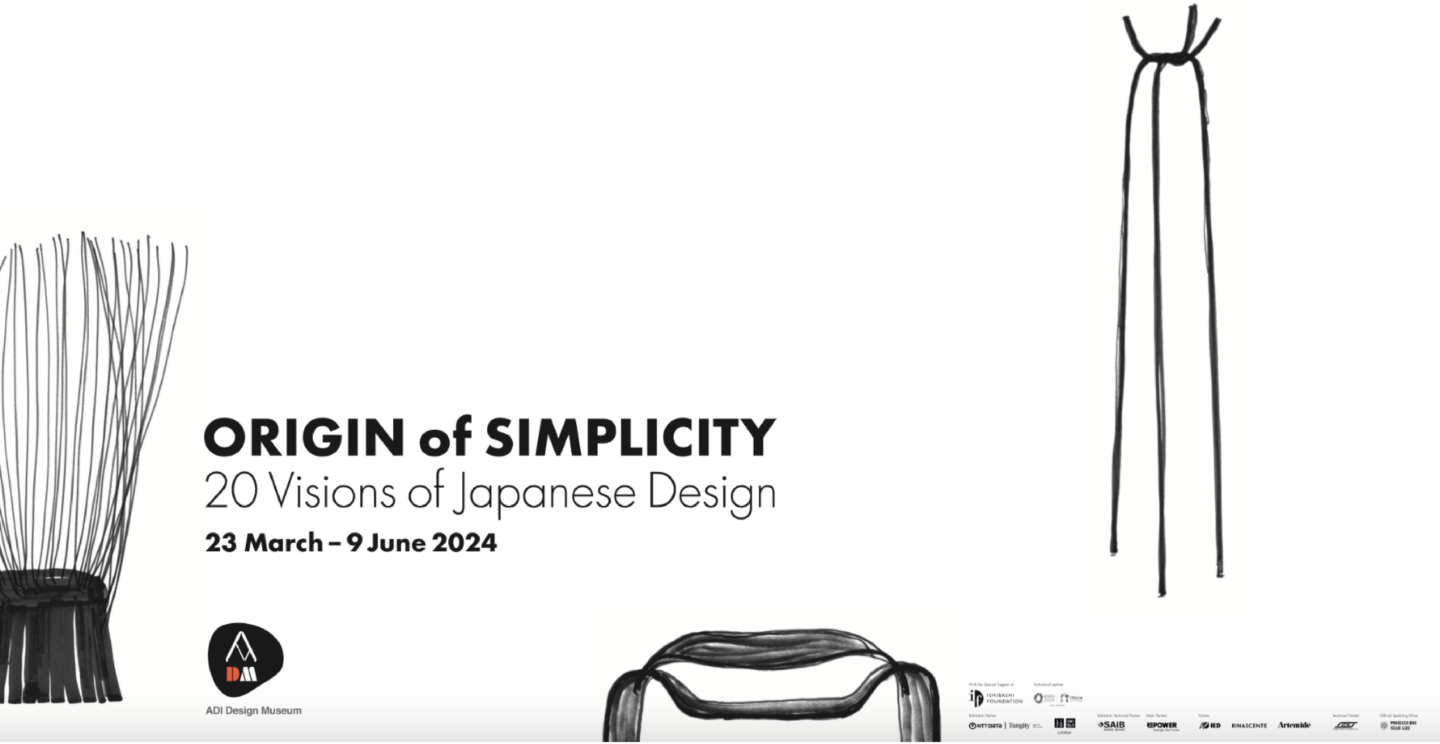Concept
March 23rd – June 9th, 2024
curated by Rossella Menegazzo
exhibition set-up and graphic design by Kenya Hara
The essentiality of shapes, the utmost attention to detail and the uniqueness of each piece in the legacy of tradition, combined with current technological and engineering research that develops new and recycled materials, are the distinctive features that make Japanese design an international icon.
The exhibition entitled “ORIGIN of SIMPLICITY. 20 Visions of Japanese Design” is a transversal overview through design and craftsmanship in order to understand the origins of the very concept of simplicity, which can be interpretated as emptiness (ku), space or silence (ma), sometimes readable as poverty (wabi) and consumption linked to use over time (sabi), and on other occasions as asymmetry, non-definition and imperfection: all concepts rooted in diverse philosophical schools of thought belonging to this culture ranging from Zen Buddhism to Shinto animist thought and almost the opposite of Western rationality.
The exhibition is a brand new piece of research conceived by curator Rossella Menegazzo, a researcher into the history of Japanese art and culture from the University of Milan, together with graphic and exhibition design by Japanese designer and curator Kenya Hara, who conceived the exhibition itinerary as a forest through which to walk. Each tree group gathers together objects with the same quality, original combinations of works by different designers and artisans, through which the theme of simplicity is expressed with key words aiming at reflecting the nature of the objects and leading the visitor through the exhibition experience.
On display there are over 150 works, mostly unseen before in Italy and designed by the most representative names in modern and contemporary design, some of whom have written the history of Japanese design starting from the 1960s, along with other exponents from later generations who are less known to the international public.
All the objects chosen highlight hand-crafted skills which have traditionally combined techniques, materials and shapes together with design handed down from generation to generation through historic workshops, ateliers and master craftsmen considered to be “living national treasures”, and as such, an intangible heritage.
This centuries-old wisdom reveals a predilection for natural materials such as wood, paper, metal, ceramic and textiles and a sensitivity towards the characteristics of each of these, making the distinction between a design or art product particularly fluid. As such, “simplicity is born specifically from a profound adherence of forms to nature, almost an attempt to preserve that sacredness inherent in every element that Shinto animistic thought brings with it and laying the foundations of Japanese culture” in the words of curator Rossella Menegazzo.
This approach intends to underline the close link between design and craftsmanship and the always subtle balance between matter and human beings, technique and technology which is a constant feature of Japanese production.
The research project was made possible thanks to the special support of Tokyo’s Ishibashi Foundation, to whom ADI President Luciano Galimberti offers thanks for “the valuable agreement that has made it possible to carry out an unprecedented project of analysis and spreading of Japanese design in comparison with Italian design, presenting the public with the cultural and artistic value, objectives and mission of the Foundation since its origins in 1956. It is interesting to remember that just a few years earlier in 1954 in Italy, both ADI and the Compasso d’Oro Award were created, with the same objective of promoting the popularisation and excellence of the Italian design system.
Approximately 70 years later both of these organisations share the same desire to produce a unique display event which after the exhibition held in our spaces in Milan, we hope will continue as far as Tokyo and beyond.”
Part of the celebration of these themes was the setting-up of the partnership with UNIQLO, a clothing brand that expresses the value of simplicity in its motto “Simple made better”. The Japanese values expressed in the exhibition are therefore also present in the design of the brand, with the common intention of emphasizing Japanese cultural roots and describing its long-lasting and transversal fascination. UNIQLO LifeWear – the brand’s founding philosophy – is characterized by a simple design that conceals accurate and modern details and which has been chosen to be accessible to all. After the success of Cordusio, the brand will open a new Milan store in Gae Aulenti during the opening months of the exhibition, thus setting the seal on a spatial, as well as cultural, proximity to the museum.
One of the main global players in the field of IT Consulting and Services, the Japanese multinational NTT DATA is another of the exhibition’s partners. This partnership aims to promote the cutting-edge technology that summarises the company’s mission and which, thanks to the Tangity studio (which is part of the Group) also impacts the design of objects and services, as well as being a symbol of the wide range of Japanese design quality.
The exhibition – produced by ADI Design Museum with The Museum Box – is therefore also an opportunity for a rereading of the relationship between Japanese design and Made in Italy and its widespread abilities, as demonstrated by the various collaborations of iconic Italian design brands with Japanese designers who have received the Compasso d’Oro Award.
DESIGNERS
Aiba Kyoto, Kosuke Araki, Asahi Kogyo, Keiji Ashizawa, Shin Azumi, Cini Boeri, Domyo Co. Ltd, DRILL DESIGN, Kenji Ekuan, Kenji Fujimori, Taiji Fujimori, Shigeki Fujishiro, Keisuke Fujiwara, Naoto Fukasawa, Hiroki Furukawa, Gyokusendo, Hakuchikudo, Kenya Hara, Jun Hashimoto, Makio Hasuike, Masayuki Hayashi, HIDA, Keiko Hirano, Honoka, Toshiaki Horio, Isao Hosoe, Youna Ichikawa, Inden’ya , Koichiro Isezaki, Jun Isezaki, Junya Ishigami, Toyo Ito, Setsu Ito, Shinobu Ito, Hisao Iwashimizu, Kaikado, Chie Kanayama, Genta Kanayama, Yuma Kano, Kahori Katano, Tomu Katayanagi, Kawahira Sekishu, Motomi Kawakami, Rei Kawakubo, Kenzo, Toshiyuki Kita, Kiya, Mikiya Kobayashi, Koizumi Studio, Kohchosai Kosuga, Kengo Kuma, Shiro Kuramata, Jin Kuramoto, Kurikyu, Shunji Kurimori, Mariko Kusumoto, Tonbii Kyoto, Reality Lab, Tsukiji Masamoto, Takeo Masui, me Issey Miyake, Haruka Misawa, Ben Ryuki Miyagi, Issey Miyake, Yoshiyuki Miyamae, Miyake Design Studio, Masahiro Mori, Muji, Shuji Nakagawa, Ryuji Nakamura, Nature Architecs, Yukito Nishinaka, Ryue Nishizawa, Isamu Noguchi, Nomena, Shinichiro Ogata, Ken Okuyama, Ryobian, Katsuhisa Sano, Takeshi Sawada, Kazuyo Sejima, Atsushi Shindo, Soil, Sen no Sotan, Reiko Sudo, Sus inc., Ryo Suzuki, Yasuhiro Suzuki, Syouryu, Hiroki Takada, Hiroko Takahashi, Takeo Paper, Momoko Takeshita, Kazumi Takigawa, Takt project, Nao Tamura, Tanabe Chikuunsai IV, Ikko Tanaka, Keiichi Tanaka, Yuki Tanaka, Tendo Mokko, Norihiko Terayama, Shono Tokuzo, Kei Tominaga, Torafu Architects, Takeshi Tsujino, Masanori Umeda, Shinichi Utsumi, Riki Watanabe, Daisuke Yamamoto, Tatsuo Yamamoto, Sori Yanagi, Shoichi Yokoyama, Satoshi Yonezawa, Tokujin Yoshioka
Partner
Uniqlo
NTT DATA








